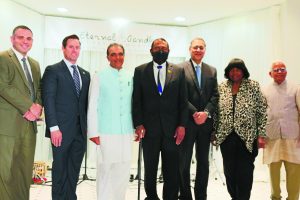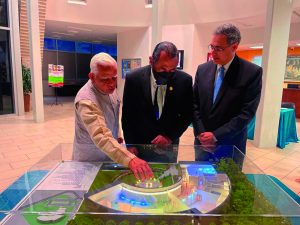EMGH Honors Congressman Al Green, Provides Construction Update

Dignitaries at the reception at India House on July 18 included Bellaire Mayor Andrew Friedberg (left), City of Houston Treasurer Chris Brown, Emcee and EMGH Truestee Dr. Manish Wani, Congressman Al Green, CG Aseem Mahajan, Dr. Alma Allen, and Trustee Atul Kothari. Photo: Namita Sutaria.
By Pramod Kulkarni
HOUSTON: Peace through non-violence is one of the eternal preachings of Mahatma Gandhi. An eternal venue to convey the life and teachings of India’s Father of the Nation will soon be a reality at the Eternal Gandhi Museum of Houston (EMGH).
At a reception at India House on the evening of Saturday, July 16, EMGH trustees honored Congressman Al Green before a select audience of donors and dignitaries. Cong. Green was responsible for the passage of community funding of $3 million through the US House of Representatives and the Senate.
Budgeted for a total cost of $13 million, EMGH is a three-acre facility at 12379 Riceville School Road, adjacent to Sam Houston Tollway and West Airport Road in southwest Houston. EMGH trustees have raised about $7 million of the funding through government funding, foundation grants, and private donations.

EMGH Trustee Atul Kothari (left) describes features of the EMGH model to Congressman Al Green and Consul General Aseem Mahajan. Photo: CGI Houston
EMGH is a cultural and educational museum dedicated to preserving Mahatma Gandhi’s legacy of nonviolent conflict resolution by cultivating universal values of truth, nonviolence, peace, love, and service. Opening in 2023, it will be the only museum in the Americas dedicated to Mahatma Gandhi.
At the reception on July 18, Dr. Manish K. Vani welcomed the audience and introduced the Swar Sangam choir, which presented two of Gandhi’s favorite bhajans, “Vaishnav Janato” and “Ram ka Gungan”. Swar Sangam returned to the podium at the conclusion to lead the audience in singing of the bhajan, “Raghupati Raghav Raja Ram”.
Keynote speaker for the evening was Dr. Clayborne Carson with Stanford University, who spoke about how Mahatma Gandhi not only inspired Rev. Martin Luther King, but the entire Black civil rights movement. Many of the civil rights movement leaders had visited India to speak directly to Mahatma Gandhi at his Sabarmati ashram in Ahmedabad.
Stating how EMGH represented a highlight of India’s “Azadi ka Amrit Mahotsav”, the 75th anniversary of India’s independence, Consul General Aseem Mahajan revealed that the Government of India had facilitated the donation of Gandhi’s bronze statue, which will be the centerpiece of the EMGH outdoor pavilion.

Bubble diagram shows the unique audio-visual segments of the EMGH exhibit space beginning with His Journey, followed by Our Journey, and then My Journey.
Chris Mozier and Cynthia Torp of Solid Light, which designed the exhibit space, guided the audience through each of the unique exhibit features. Lorie Westrick of RDLR Architects explained how the humble nature of the Gandhi exhibits in India and the spinning wheel (charkha) inspired the EMGH architectural design. Tina Khatri of TDK Construction presented photos of the current state of the building. The evening concluded with dinner catered by Dawat Cuisine.
For more information, visit www.emgh.org.
